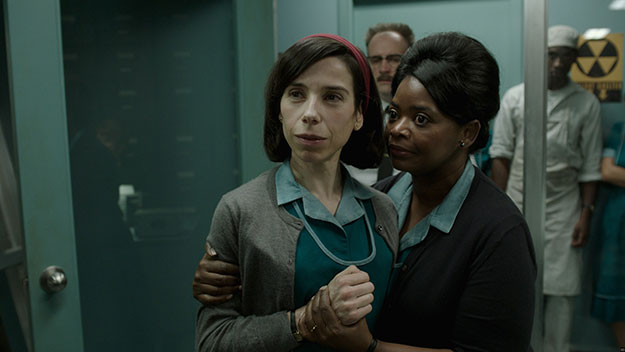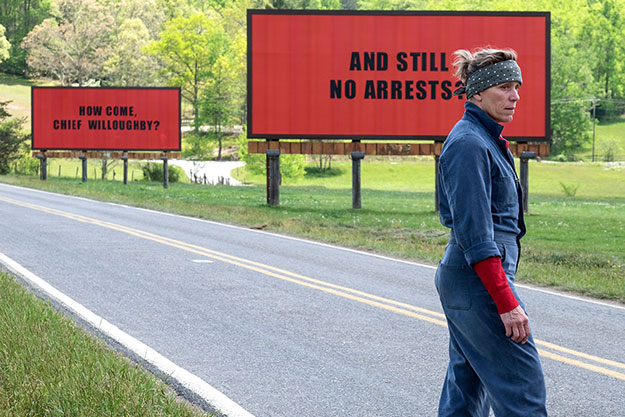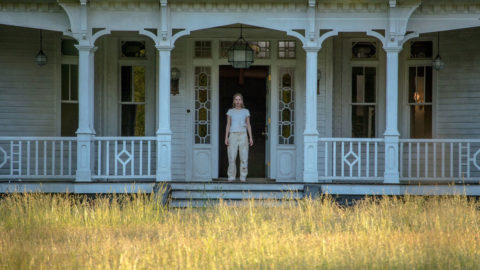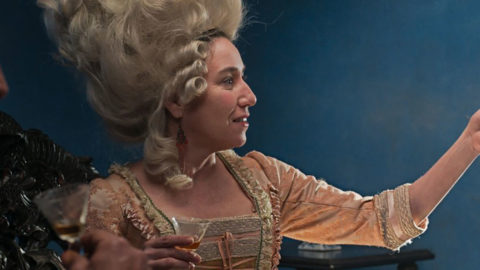Festivals: Venice 2017

The Shape of Water
Press screenings at the Venice International Film Festival take place primarily in two buildings on the Lido, the Palazzo del Cinema and the Palazzo del Casino. These were built in 1937 and 1938 respectively (in record time, the festival website points out), and the Casino’s majestic halls and windows can put you in mind of The Conformist as you dash off an email among ever-replenished legions of European journalists. But the decade writ large at this year’s edition was not the 1930s, but the 1950s, if only thanks to a couple of high-profile studio films that re-created its zeitgeist as a meticulously curated waking nightmare with pointed lessons for the present.
One of these, The Shape of Water, won Guillermo Del Toro the festival’s top prize, the Golden Lion, surprising some who had doubted that a lovingly (old-)fashioned comic-book fantasy could be so honored. In a way, that fantastical eventuality was presaged by the opening night film, Alexander Payne’s handwringing yarn Downsizing, set in the not-too-distant future when the end is ever nigh-er and businesses arise that zap people to a fraction of their size in the latest twist on the American Dream. (I had my own moment of slight unreality when I glimpsed, on the roof of the Palazzo del Cinema, the glass-boxed room in which the competition jury, led by Annette Bening and including Rebecca Hall and Edgar Wright, were conferring like the gods on Mount Olympus.) Del Toro’s fairly conventional tale of underdog forbidden romance—between a fish-man creature in government captivity and a mute cleaning lady, Eliza (Sally Hawkins), facing off with a hateful investigator (Michael Shannon)—was nonetheless warm, sumptuously shot and designed, and barbed with semi-subversive asides from Eliza’s outsider buddies, fellow worker Zelda (Octavia Spencer) and a closeted illustrator neighbor (Richard Jenkins). Resembling a children’s movie for grown-ups while reining in Del Toro’s worst tendencies, its hybrid form holds clear appeal for another year when the highest-grossing films replace humans with costumed superheroes and animated creatures, our postmodern costume dramas.
George Clooney’s hobbled Suburbicon also springs partly from the same moral universe as Downsizing, whose strongest aspect was the tug between making a difference to individuals and making large-scale change in a doomed world. Grounded in the true sordid legacy of discrimination in Levittown, Suburbicon is a Coen Brothers–scripted crime drama that sets the stage for social commentary. Family man Matt Damon (wearing Establishment specs) gets into hot water with the mob and the insurance company after conspiring with his wife’s sister (both wife and sister played by Julianne Moore)—all of which unfolds against a backdrop of bigotry as their neighbors, a black family, are hatefully hounded and attacked by the rest of the town. Damon is a shapeless lump at the center of this film, but amid the strained skullduggery and tract-housing dress-up, Clooney does succeed in staging something resonant through parallel narrative alone: Damon’s white company grifter brings all his trouble and strife upon himself, while his neighbors’ lives are ruined through absolutely no fault of their own.

Three Billboards Outside Ebbing, Missouri
Wormwood, Errol Morris’s six-part Netflix series, also offered Venice attendees an immersion in Fifties World (and beyond) with its retracing of a U.S. military scientist’s death following a bizarre LSD experiment, and his dauntless son’s decades-long investigation. Three Billboards Outside Ebbing, Missouri felt perversely aimed at other dicey legacies of America, in the toxic heart of small-town Southern corruption, but Martin McDonagh’s mannered distortion of characters into foul extremes and narrative convenience evoked a London playwright’s stunt-pulling more than genuine lived drama (and with anyone other than Frances McDormand as the vengeful mother, it would be patently absurd). That being said, it might seem surprising that right at the top of my list in Venice was a film consisting largely of an interview with a Japanese celebrity cannibal (and his masochistic brother). Yet in Caniba, filmmakers Lucien Castaing-Taylor and Véréna Paravel achieve their unnerving effect through the most elemental of techniques, all-encompassing close-ups and temps mort (as it were) that make us feel their subject’s presence and absence. (More on all that in my interview with these nonfiction pioneers of Harvard’s Sensory Ethnography Lab.)
Grueling in quite a different way is Darren Aronofsky’s assaultive mother!, a hallucinatory psychodrama kept under a tight lid in the weeks leading up to its premiere. Long ago impatient with Aronofsky’s literal-minded approach to subjective cinema, I was happily surprised to settle into this seamlessly bonkers movie and its first-person view of domestic and global apocalypse. While the malleable allegory of the film’s events—a woman and her writer husband live in an Edenic country house that spirals into infernal chaos—has fueled both love-or-hate reactions and directorial marketing, I was riveted by the heedless spectacle and totally enveloping film technique, all anchored in Jennifer Lawrence’s sometimes baffling commitment to a character driven to distraction by her husband (Javier Bardem), his mystery guests (deliciously entitled Michelle Pfeiffer, Ed Harris), and much, much more. Apart from the biblical obsessions, Aronofsky here again restages the creative act as trauma, down to the sadistic consumption of a muse figure. It’s a jaw-dropping circus-like self-immolation by a filmmaker, easy to mock but not to shrug off, and it doubles as a remarkable representation of contemporary sensory overload and the warped continuity of subjectivity created by a glutting landscape of social and other media.
Maybe it was the comparatively lackluster films elsewhere in the slate, but it took a mother! to jolt an audience awake—and Brawl in Cellblock 99 did its own little number at midnight, when the two-hour-plus thriller ambitiously screened. Director Craig Zahler follows big lug Vince Vaughn through a prison revenge thriller, planting the camera at Seidl room-centering mid-height for a businesslike series of face-offs and beat-downs. Like Aronofsky but on a far smaller scale, Zahler maintains an unexpected formal control that pushes ludicrous material into the realm of pleasing cinematic frenzy (aside, of course, from the sleep-walking runtime). Samuel Maoz’s Foxtrot, winner of the Silver Lion after Del Toro, also gave the festival a shot in the arm with its pure energy and faith in setpiece staging and the timely close-up.

Zama
And finally, all praise to Venice for showing Lucrecia Martel’s Zama, just as humidly mysterious and concentrated as you’ll have heard. My colleague Jose Teodoro takes you down that river in our September/October print issue, but suffice to say that Martel, following our titular Spanish imperial functionary off the deep end with as fine a literary adaptation as has been seen in years, has lost none of her capacity for the fear and wonder of cinema.







